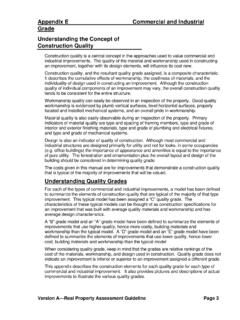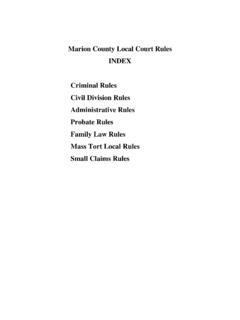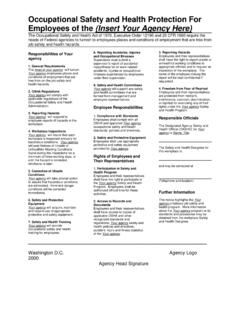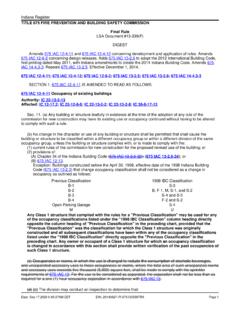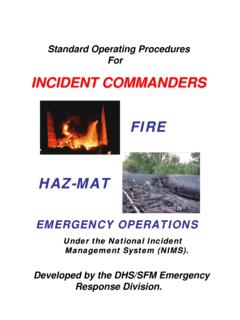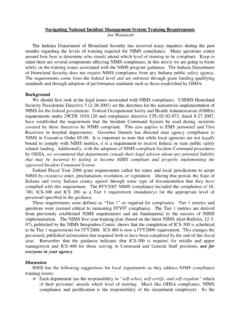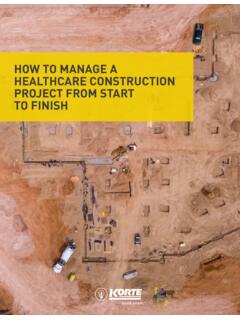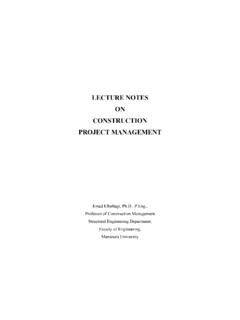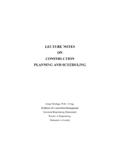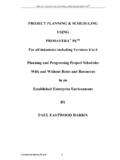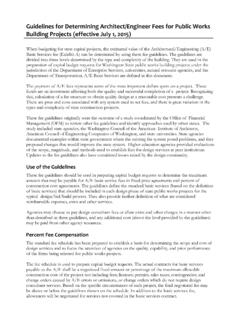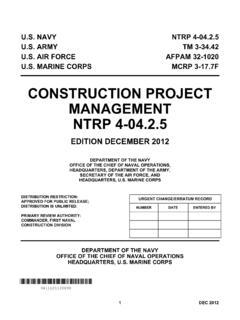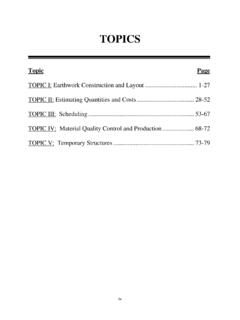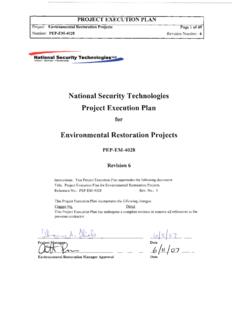Transcription of Maintenance of Traffic Design - IN.gov
1 INDIANA DEPARTMENT OF TRANSPORTATION 2013 Design MANUAL. CHAPTER 503. Maintenance of Traffic Design Revision Date Sections Affected Memorandum Ch. 81-83 superseded by Ch. 503. Following sections effective with Stage 2 submittal on or after November 1, 2019. (13) Pedestrian Accessibility 19-12 Oct. 11, 2019. Positive Protection Temporary Traffic Control Devices All other sections effective with Stage 1 submittals on or after October 11th. 20-12 Aug. 2020 (04). 20-24 Nov. 2020 and (01). 21-10 Apr. 2021 TABLE OF CONTENTS. TABLE OF 2. LIST OF FIGURES .. 5. 6. TRANSPORTATION MANAGEMENT PLAN .. 6. Federal Highway Administration (FHWA) Rules on Work Zone Safety .. 7. Work Zone for Significant and Non-Significant Projects .. 7. (01) Significant Projects.
2 7. (02) Non-Significant Projects .. 8. Indiana Traffic Management Area .. 9. TMP Development .. 9. (01) The TMP Team .. 9. (02) TMP Team Responsibilities .. 10. Traffic Control Strategies .. 12. (01) Traffic Control Strategy Terminology and Guidelines .. 12. (02) Selecting a Traffic Control Strategy .. 15. (03) Complete Closure of an 20. (04) Work Zone Phasing for Maintaining Traffic adjacent to the Work Area .. 22. (05) project Scheduling .. 24. Contract Provision Strategies .. 25. (01) Incentive/Disincentive Clause and Justification .. 25. (02) A + B Bidding .. 26. (03) Cost Evaluation .. 26. Traffic Impact/Queuing Analysis .. 27. (01) Queue Estimating .. 29. (02) Detour Cost Evaluation .. 30. (03) User Cost Evaluation.
3 31. TEMPORARY Traffic CONTROL PLAN .. 32. Traffic Control Plan Development .. 32. (01) Responsibilities .. 32. (02) Content .. 33. (03) Schedule .. 35. (04) Design Considerations .. 37. Interstate Highways Congestion 41. Work Zone Traffic Capacity .. 42. Work Zone Design 43. (01) construction Zone Design 43. (02) Lane or Shoulder Width .. 44. Page 2 2013 Indiana Design Manual, Ch. 503. (03) Transition Taper Rate .. 46. (04) Sight Distance .. 47. (05) Horizontal Alignment .. 47. (06) Vertical 48. (07) Cut or Fill Slope .. 48. (08) Maximum Profile Grade .. 49. (09) Through-Lane Cross Slope .. 49. (10) Vertical Clearance .. 49. (11) Drainage During construction .. 49. (12) Temporary Crossover Pavement 49. (13) Pedestrian Accessibility.
4 49. Road User and Worker Safety .. 50. (01) Positive Protection .. 50. (02) Use of Positive Protection .. 51. (03) Design Considerations for Use of Positive Protection .. 52. (04) Positive Protection Devices [Rev. Aug. 2020] .. 53. (05) Design Layout .. 57. (06) Pavement Edge Drop-Off .. 59. (07) Temporary Transverse Rumble Strips .. 59. TRANSPORTATION OPERATIONS PLAN .. 61. TOP Development .. 61. Other Traffic Mitigation Measures [Rev. Apr. 2021] .. 64. Traffic Monitoring Procedures for Work Zone .. 66. Incident Management Plans .. 66. PUBLIC INFORMATION PLANS .. 66. WORK VEHICLE Traffic CONTROL PLANS .. 67. Work Vehicle Traffic Control Plan (WVTCP) Development .. 67. Resources .. 68. (01) Occupational Safety and Health Administration Regulations.
5 68. (02) Indiana Manual on Uniform Traffic Control Devices .. 68. TEMPORARY Traffic CONTROL DEVICES .. 69. Temporary Traffic Control Signs .. 69. (01) Placement .. 69. (02) Regulatory Signing .. 70. (03) Advanced Warning 74. Sign Sequence .. 74. construction Ahead Sign .. 75. Worksite Increased Penalty Signs .. 75. (04) Guide Sign .. 77. 2013 Indiana Design Manual, Ch. 503 Page 3. (05) Portable Changeable Message Sign .. 77. (06) Flashing Arrow Sign .. 80. Channelizing Devices .. 81. (01) Types .. 81. (02) Taper Length .. 83. (03) Spacing .. 83. (04) Type III Barricade .. 83. Temporary Pavement Markings [Rev. Nov. 2020] .. 85. (01) Types [Rev. Nov. 2020] .. 85. (02) Application .. 87. Temporary Traffic Control Signals.
6 88. (01) Location .. 88. (02) Application .. 88. Automated Flagger Assistance Devices .. 91. Illumination of Nighttime Work Zone .. 92. (01) Types .. 92. (02) Warrants .. 92. FIGURES .. 94. Page 4 2013 Indiana Design Manual, Ch. 503. LIST OF FIGURES. 503-2A Typical Highway Capacity 503-2B Identifying Feasible Work Zone Traffic Control Strategies 503-2C Reconstruction by Halves, Sides 503-2D Parallel or Adjacent Reconstruction 503-2E Serial or Segmental Reconstruction 503-3A Participants During Traffic Control Plan Development 503-3B Minimum Radius for Horizontal Curve in construction Zone 503-3C Flare Rates for Temporary Concrete Barrier in construction Zones 503-3D K-Values for Sag Vertical Curve (Comfort Criteria). 503-3E construction Clear Zone Width 503-3F Traffic Control for Pavement Drop-Offs (for Freeways and Expressways).
7 503-7A Suggested Temporary Speed Limits for Freeways and Expressways 503-7B Advance Warning Signs 503-7C Suggested Use and Location of Arrow Boards 503-7D construction Zone Taper Length Criteria 503-7E Application of construction Zone Taper Length Criteria 503-7F Suggested Maximum Spacing of Channelization Devices 503-7G Transverse Rumble Strips 503-7H Typical Vehicle Detection for a Fixed Temporary Signal 2013 Indiana Design Manual, Ch. 503 Page 5. CHAPTER 503. Maintenance OF Traffic . GENERAL. Where the normal operation of a roadway is suspended, the Maintenance of Traffic (MOT) will provide for the continuity of vehicle, bicycle, and pedestrian Traffic as well as access to property and utilities. MOT has two objectives: 1.
8 Provide for reasonably safe and efficient road-user movement through or around a roadway work zone to protect workers, incident responders, and equipment. 2. provide for the efficient completion of the construction or Maintenance activities interrupting the normal operation of the roadway. MOT Design should begin during the planning phase of a project and continue through the project 's completion of construction . The Indiana Manual on Uniform Traffic Control Devices (IMUTCD). requires that MOT Design consider the needs of construction workers and road users, including persons with disabilities, in accordance with the Americans with Disabilities Act of 1990 (ADA). For projects that have significant impacts to the public (see Section ), and when necessary for other projects, the TMP will include a Transportation Operations Plan (TOP), and a Public Information Plan (PIP).
9 All projects need a TMP and all TMP's need to have a TTCP. TMP on significant projects also must have a TOP and PIP. The Engineer's Report should indicate whether a project will have significant impacts and have a TMP that includes a TOP and PIP. The guidance and procedures contained in this chapter should be applied to Design -build projects as well as Design -bid-build projects. Technical provision prepared for Design -build projects should include this requirement. TRANSPORTATION MANAGEMENT PLAN. A Transportation Management Plan (TMP) is an overall strategy to accommodate Traffic during road work that minimizes adverse impacts and maximizes safety or and mobility. The TMP should minimize the exposure to potential hazards for both motorists and highway workers in the work zone vicinity.
10 The TMP should also minimize the vehicular delay in the work zone vicinity. Page 6 2013 Indiana Design Manual, Ch. 503. All projects require a TMP. The scope, content, and degree of detail present in a TMP will vary based on identifying the project as significant or non-significant in relation to work zone impacts, see Section Federal Highway Administration (FHWA) Rules on Work Zone Safety The Work Zone Safety and Mobility Rule and the Temporary Traffic Control Devices Rule appear in the Code of Federal Regulations 23 CFR 630 Subparts J and K respectively. The Work Zone Safety Rule requires every state to have a policy for the systematic consideration and management of work zone impacts on all federal-aid highway projects.
